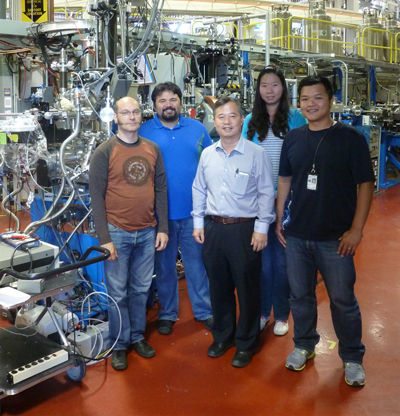
Jinghua Guo, a senior scientist at the Advanced Light Source (ALS), is the 2022 winner of the David A. Shirley Award for Outstanding Scientific Achievement at the ALS. In selecting him for this honor, the ALS Users’ Executive Committee (UEC) recognizes Guo for pioneering the development of in situ/operando soft x-ray spectroscopy for energy, catalysis, and chemical science. As this year’s Shirley Award honoree, Guo will deliver a keynote talk at the ALS User Meeting next month.
“I was a little bit surprised actually, but I’m pretty happy and excited to see that this work has been recognized by the UEC,” said Guo. “Maybe I was the one named, but it’s really a staff and user collaboration. It’s a good recognition of the way we do things at the ALS—with a kind of innovative spirit, something different than conventional.”
In his nomination letter, Gao Liu of Berkeley Lab’s Energy Storage & Distributed Resources Division wrote that Guo “has established himself as the world-leading expert and pioneer” in the areas of in situ and operando soft x-ray spectroscopy, making “key contributions to the development of the experimental tools for soft x-ray spectroscopy of liquids and solid/liquid interfaces.”
The central challenge in these studies is the design of sample environments capable of dealing with the shallow penetration depth of soft x-rays and the need to operate chemical reactions in high vacuum. Thin “membrane” silicon nitride windows are used to separate the vacuum chamber from various gas and liquid environments while allowing soft x-rays to pass through. “We use 100 nm thick membranes that allow us to have decent x-ray transmission,” said Guo. “Because at the end of the day, we need to use x-rays to excite the system and then detect x-rays coming out from it.”

Over time, as the experiments became more complex, the windows also provided a platform for supporting additional features, such as a catalyst layer exposed to an ambient gas, or metal electrodes enabling the application of electric fields or to act as current collectors for detecting electrons. Now, these techniques and instruments are regularly used at other synchrotron facilities around the world.
“The ALS operando cells have been implemented at NSLS-II and Taiwan Light Source, and the cell design has been adopted by Sirius and many ALS user groups,” wrote Liu. “It also opened eyes to the feasibility of in situ studies of samples at real-world conditions, which is of great importance for applications in the environmental and energy research sectors.”

Guo first came to the ALS in 1994, when he was a Ph.D. student focusing on gas-phase experiments, supervised by Joseph Nordgren at Uppsala University in Sweden. At the time, the endstations planned for Sector 7 weren’t yet ready. “So, we got a deal where we could bring an endstation from Sweden to the ALS and just plug it into Beamline 7.0.1,” said Guo. “I was the first one to take the beam.”
Because of the small beam size, Guo’s early gas cell was able to use a small window, which he constructed using a piece of silicon nitride shared with him by a neighborly user from Brookhaven, Janos Kirz, who later went on to serve as ALS director. “I don’t know where he got them, but he gave three pieces to my supervisor,” said Guo. “So we were able to build up the window, and from the window, we built up the cell.”
After a year in Berkeley, Guo returned to Uppsala but came back to the ALS for good in 2001 as a beamline scientist. He now leads the ALS resonant inelastic x-ray scattering (RIXS) program, which encompasses five beamlines. Over the past 20 years, he has developed partnerships with scientists around the world and mentored or hosted many visiting users, including faculty members, postdoctoral fellows, and students.
Guo’s collaborative work has resulted in publications covering a wide range of topics. Highlights include papers on the structure of water/alcohol mixtures, hematite electrodes for water-splitting, cobalt-platinum nanocatalysts, the molecular structure of water at an electrode surface, supercapacitor electrodes, graphene-wrapped nanocrystals for hydrogen storage, and a seaweed-sourced stabilizer for lithium-sulfur batteries.

Guo recalls that his doctoral supervisor, Joseph Nordgren, who served for 10 years on the Nobel Committee for Physics, would talk about insights he got from spending several months every summer reading the material. “Sometimes you really need to sit tight, to do things,” said Guo. “With the gas cell, we spent months trying different concepts to seal the cell. It all worked out eventually, with a lot of help from ALS engineering and others. And a little luck. You may be lucky next time, so keep going,” said Guo.
Not every path will lead to a Nobel Prize, of course, but small steps keep scientific progress moving. “I think you can say that the impact of this award recognition to me is that it will keep us thinking about innovations, small things that can change a lot,” said Guo. “Change the way we do science, leading toward bigger science.”
The Shirley Award is named after David Shirley, a professor of chemistry at UC Berkeley and director of Berkeley Lab from 1980 to 1989, whose vision was instrumental in building the ALS. Recipients of the award are selected by members of the ALS UEC, with input from ALS staff members representing the Recognition Task Force of the ALS Inclusion, Diversity, Equity, & Accountability (IDEA) Committee.
Each year, the Shirley Award recipient is invited to address a plenary session of the ALS User Meeting. This year, the Shirley Award talk is scheduled for Monday, August 15, at 10:00 a.m. PDT. Because the meeting will be held online, attendance is free and open to all who register.